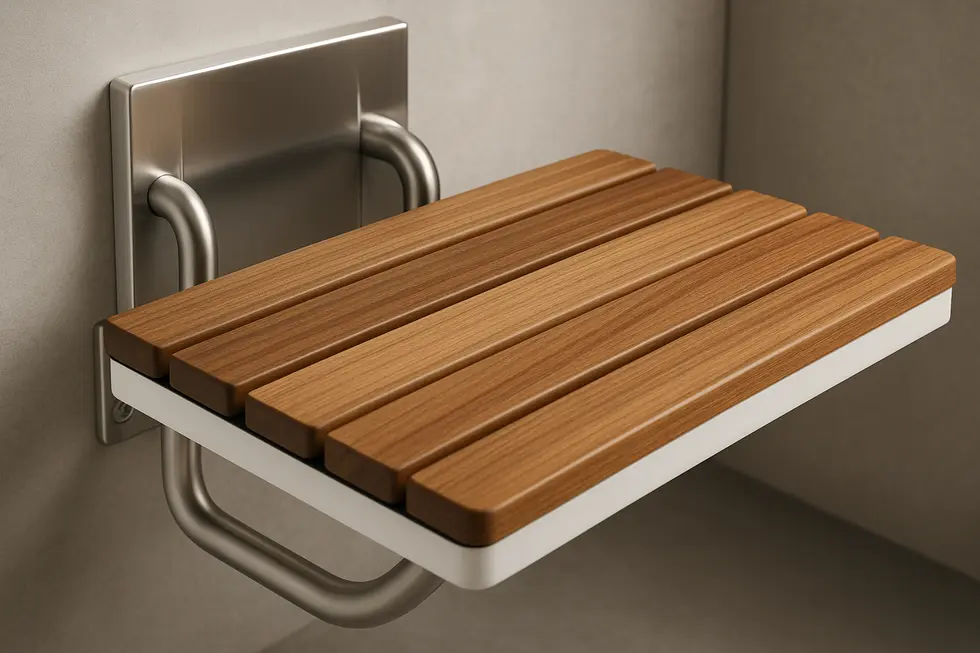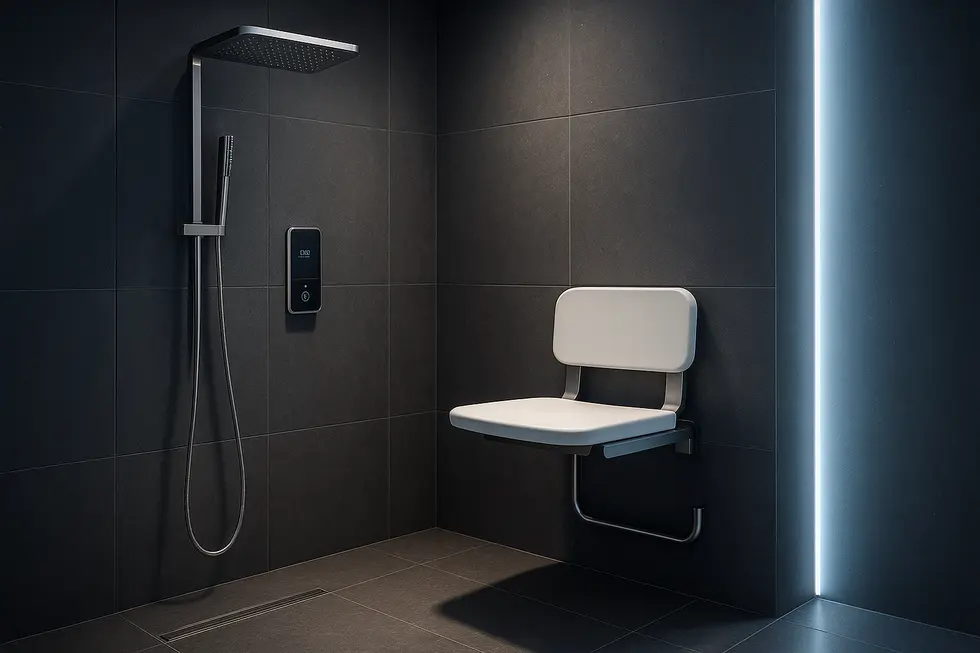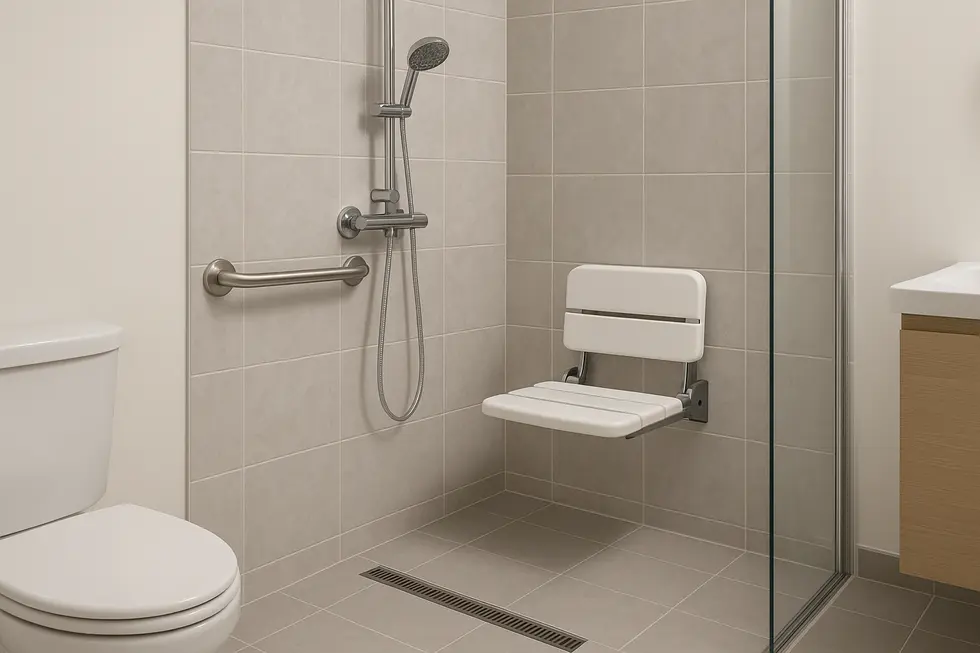Shower Seat
Elevating Safety and Style: Choosing the Best Wall Mounted Shower Seat
Amidst a growing focus on safety and accessible bathroom solutions, wall-mounted shower seats stand out as essential products. These seats offer not only convenience and comfort but also play a critical role in enhancing bathroom safety for family members of all ages. This article explores how safety and compliance standards, meticulous design choices, and evolving market trends shape the selection of the best wall-mounted shower seats, ensuring they meet your family’s needs both today and tomorrow.
Engineering Peace of Mind: Meeting Safety and Compliance Benchmarks in Wall-Mounted Shower Seats

The true value of a wall-mounted shower seat is confirmed only when its graceful fold-down silhouette hides a rigorously engineered safety core. Every critical dimension, alloy choice, and fastener torque speaks to a single objective: keep the user upright, comfortable, and free from harm. Industry consensus now treats a 300-pound static load as the absolute floor, while premium models certify 400–500 pounds to accommodate dynamic movements like lateral transfers. Those figures are not marketing bravado; they echo EN 12182 test rigs that clamp the seat under 150 kilograms for an hour, then cycle the hinge 20,000 times before salt-spray chambers probe for corrosion scars.
Compliance begins with geometry. The ADA fixes the seat top at 17–19 inches above the finished floor so knees align naturally for a standing pivot, and it insists the folded profile intrude no more than 6 inches into the shower’s clear floor space. To satisfy users with diminished upper-body strength, modern hinges integrate spring assists that hold deployment force under 20 newtons—roughly the effort needed to press a laptop key repeatedly. Surfaces matter just as much. Solid phenolic panels produce a wet dynamic coefficient of friction above 0.60, surpassing ANSI A326.3 guidelines and allowing bare skin to remain steady even when soap film builds. Rounded edges, shaved to a sub-6 millimetre radius, blunt impact energy if a leg slips sideways.
The unseen mounting substrate is the final guarantor. Behind every gleaming seat should sit 2 × 10 solid blocking or 12-gauge steel studs; stainless lag screws torqued to 9–12 N·m bite deep enough to resist 60 ksi shear loads without galling. A bead of 100 percent silicone or an EPDM gasket seals the flange to halt water migration that could rot framing and degrade holding power.
Periodic audit extends the service life. A quick monthly check for wobble, hinge squeak, or discoloration flags fatigue early. For a detailed installation checklist, consult the manufacturer’s installation guide. For broader advice on preventing slips and falls, our dedicated overview of shower-seat safety offers further insights: comprehensive safety considerations.
Steel, Teak, and Torque: How Materials and Mounting Determine the Best Wall-Mounted Shower Seat

Material chemistry defines longevity. The highest-performing seats rely on AISI 304 stainless steel, whose 18 % chromium and 8 % nickel create a self-healing passive film that shrugs off steam, shampoo acids, and the occasional bleach wipe. Aluminum frames lighten the unit by nearly 30 %, but their anodized skin demands meticulous sealing at screw holes to prevent pitting. When it comes to what actually touches the skin, dense phenolic resin offers hospital-grade hygiene, while kiln-dried teak adds a warm, spa aesthetic and Class 1 natural rot resistance. Whichever surface you prefer, insist on a non-slip texture registering at least 0.60 wet DCOF—anything lower invites a slide rather than a seat.
Design mechanics turn raw material into user confidence. Look for hinge arms tested through 20 000 open-close cycles and a fold-down force below 20 N; the latter ensures that aging shoulders or arthritic hands can deploy the platform without strain. Rounded corners (<6 mm radius) eliminate pressure points, and concealed fasteners keep towels and clothing from snagging. Advanced models now incorporate gas-spring lift assist: the panel eases itself upward, never slamming against tile. Just as critical is load rating. An honest capacity begins at 300 lb, yet a 400–500 lb certification—validated under EN 12182 or ISO 17966—provides a margin for dynamic loads when a user shifts suddenly.
Installation is the final engineering test. Even the strongest seat fails if mounted to weak blocking. Carve out 2 × 10 solid lumber—or 12-gauge steel plate in metal-stud walls—so lag screws bite something with an allowable shear of at least 60 ksi. Stainless fasteners torqued to 10 N·m supply clamp force without galling; a bead of 100 % silicone behind each flange stops water wicking into studs. Mount height must land between 17″ and 19″ above finished floor to align with accessibility codes, and the folded profile should leave the mandated 30″ × 60″ clear space untouched. If you need a field reference, this concise step-by-step installation guide walks through blocking, waterproofing, and torque values.
From Niche Necessity to Bathroom Mainstay: Market Trends and Consumer Desires Shaping the Best Wall-Mounted Shower Seats

The wall-mounted shower seat has quietly shifted from a clinical aid to a design-forward fixture that anchors modern, inclusive bathrooms. Analysts peg compound annual growth at 5–7 % through 2030, mirroring demographic reality: by the end of the decade, one in six people worldwide will be over 60. That swelling cohort, determined to age in place, is the catalyst that turns safety hardware into a mainstream purchase, not a specialist prescription. Commercial demand amplifies the curve; hotels now market “accessible spa suites,” while healthcare facilities view fold-down seats as a preventive investment that lowers fall-related liability.
Consumer sentiment captured in thousands of online reviews converges on three priorities. First, uncompromising strength—ratings of 400–500 lb have become table stakes, a figure that conveys reassurance even to lighter users. Second, effortlessness: lift-assist or counter-balanced hinges allow a seat to deploy with about the same force as opening a laptop, critical for arthritis sufferers. Third, aesthetics. Slim phenolic profiles, teak veneers and concealed stainless brackets let the fixture blend with rain heads and back-lit mirrors. Buyers no longer accept the institutional look; they want spa serenity, achieved without sacrificing the ≥0.60 wet DCOF textures that keep feet planted.
Installers influence purchase decisions as well. Professional forums report that seats pre-drilled for 16-inch stud spacing cut labor time by 40 %, a saving often passed on to homeowners. Some brands now ship augmented-reality templates so contractors can visualise blocking before tile goes up—evidence of how ease of installation is becoming a competitive differentiator.
Looking forward, material science will steer the next leap. Manufacturers are experimenting with recycled thermoset cores that rival phenolic in rigidity yet halve embodied carbon. Expect antimicrobial powder coats and IoT moisture sensors to migrate from hospital catalogues to residential showrooms within five years. As universal design principles embed themselves in building codes, the “nice-to-have” label will vanish; planners will specify shower seating as routinely as grab bars.
For a closer look at hinge mechanics and style variations in today’s folding wall-mounted models, see this illustrated guide. (https://pegabidet.com/2025/06/11/folding-wall-mounted-shower-seat/)
Further reading: detailed consumer feedback on load capacity, cleaning ease, and finish durability can be found at independent review archive.
Final thoughts
Selecting the best wall-mounted shower seat involves understanding a blend of safety, design, and market insights. These seats are not mere accessories; they are pivotal components of a family-friendly bathroom that provide enduring safety and convenience. From complying with rigorous standards to embracing innovative designs, the right shower seat can profoundly enhance your family’s daily ritual and offer peace of mind for years to come.
Experience a new standard of clean with PEGABidet—designed for comfort, safety, and independence. Join thousands who trust us to make personal care simple and dignified. Contact us contact@pegabidet.com
About us
PEGABidet is a brand owned by L.A NEXTGEN LLC, based in California. We design intuitive, hygienic, and accessible bathroom solutions that prioritize safety, dignity, and independence. Our mission is to make personal care effortless and empowering for people at every stage of life.

